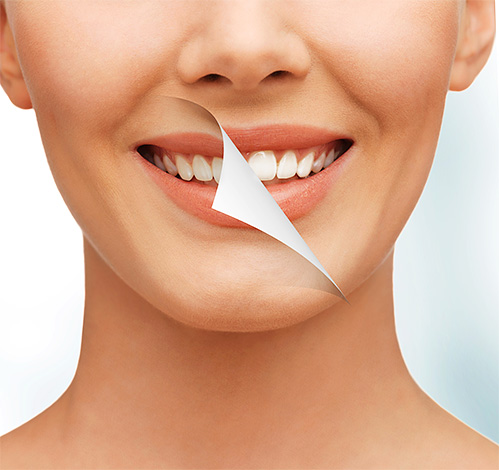
Next you will learn:
- What type of tooth whitening is the safest and most gentle in relation to tooth enamel;
- Why whitening often causes significant damage to teeth and gums and how it happens;
- How do different teeth whitening technologies (including those focused on home use) differ in safety and effectiveness;
- And also a number of interesting practical nuances that will protect your teeth and health in general from mistakes and unnecessary problems.
Everyone who is very distrustful of teeth whitening wants to say right away that safe tooth whitening really exists. However, before delving into this topic, let's first determine some nuances and terms, and see what bleaching actually hurts (why many people are so afraid of it), and what is the difference between true bleaching and lightening of the enamel surface.
Gentle whitening of teeth implies a minimal effect of the applied whitening system on the structural elements of enamel and dentin. Unfortunately, in practice this is far from always achieved, since the most effective true enamel whitening agents are combinations of substances that actively penetrate deep into the enamel surface layer and violate its normal structure. Simply put, not only coloring pigments are destroyed, but the structure of the enamel and dentin itself is simultaneously disturbed (calcium and phosphorus are washed out, the protein matrix of enamel can be affected).
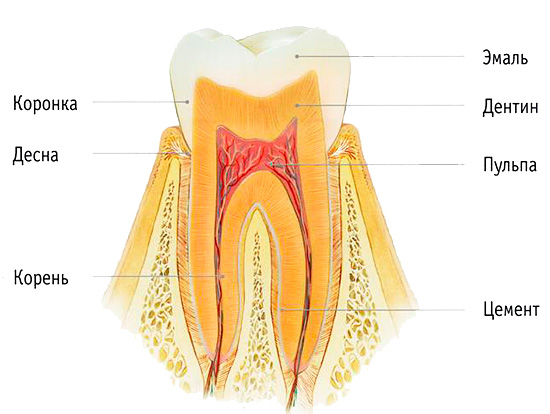
As a result, often after such an effective teeth whitening (from the point of view of a whiteness of a smile), enamel is a kind of porous sponge that needs urgent help - a remineralization procedure, including fluoridation.
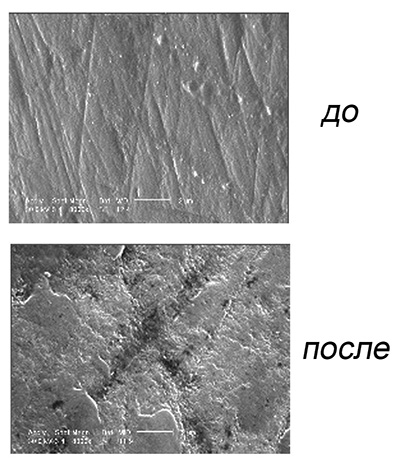
On a note
After teeth whitening, at first, a rather pronounced sensitivity of enamel to various kinds of irritants (hyperesthesia) can be observed, when it is painful to drink cold water, eat solid food, and sometimes it even hurts to just breathe through the mouth.
During the recovery period, enamel is very vulnerable to staining, for example, with wine, coffee, tea and other highly coloring solutions, therefore it is recommended to adhere to the so-called white diet for some time (sometimes also called a transparent diet). In fact, we are talking about not to consume those products that can again give the enamel a dark shade.
It is also important to distinguish between true teeth whitening and their lightening:
- Whitening tooth enamel involves the chemical (or photochemical) destruction of colored compounds in its surface layer to a certain depth. Powerful oxidizing agents simply discolor colored substances, converting them into unpainted compounds. As you know, far from always such a whitening will be safe for the teeth, but with the right approach and with strict adherence to all technology, this can be achieved.

- But tooth whitening is based on a completely different principle of operation - we are talking here about the mechanical removal of pigmented deposits from the enamel surface (for example, plaque, tartar). In this case, ultrasound, Air Flow technology, abrasive whitening toothpastes and other methods can be used. In general, tooth whitening is more gentle than true whitening, although it is very important to follow the technology.

Thus, in both the first and second cases, a positive result can be achieved: the surface of the teeth really becomes brighter.
However, if you want to choose the safest option for teeth whitening, and at the same time effective, it will be useful to first see what the potential dangers of the technologies used today are (including for home use, including various whitening pencils, strips, mouth guards).
Let's talk about this in more detail.
And why, in fact, does teeth whitening harm enamel and how dangerous is it?
If we recall the structure of human teeth, it becomes clear that their whitening (lightening) is always associated with a direct or indirect effect on tooth enamel.
Imagine a situation: a person looks in the mirror and sees that his teeth in the smile zone are yellowish. And I would like them to be at least a little whiter. The simplest thing that comes to mind is to take the brush harder and rub the surface of the teeth until a shade given to it by nature appears (in general, this is what people used to do - remember the previously popular tooth powders or brushing your teeth with charcoal , chalk and even clay).
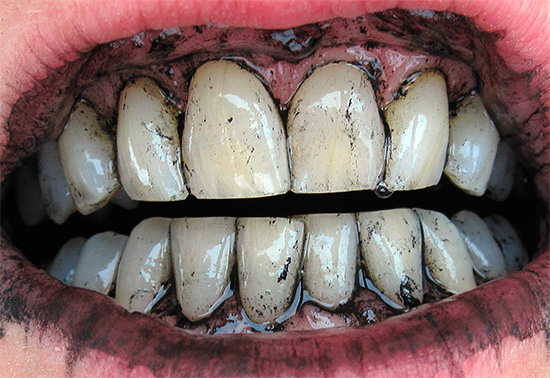
Of course, today people perfectly understand that this idea is not the most pleasant at best, and worst at worst, as it will cause tooth sensitivity from various irritants (hot, sour, cold). This is the so-called "feeling of soreness" when, for example, when biting off a solid sour apple, trembling occurs throughout the body.
On a note
Various grinding of teeth to the so-called “brilliance” often refers to the field of traditional medicine, and are used exclusively at home with great risks not only for dental health, but also for general human health. Abrasion of the surface layer of enamel in a short time without proper compensation has not led to anything good.
This also includes excessive enthusiasm for whitening toothpastes with a high RDA abrasiveness index, including toothpastes from Thailand with clay, the abrasiveness of which seems to be not standardized or controlled at all. The use of such pastes can not only lead to tooth sensitivity, but also exacerbate the problem of wedge-shaped defects, if any (see example in the photo).
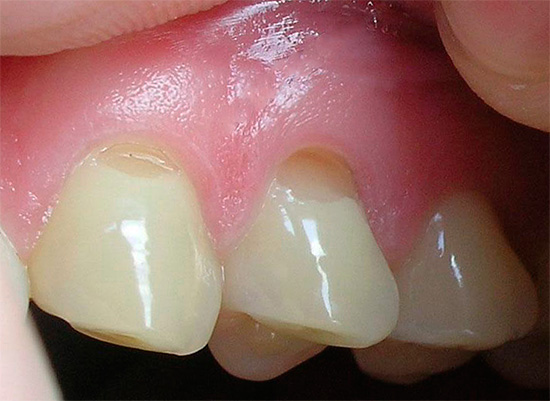
True (chemical) teeth whitening is also difficult to call safe. During the procedure, high concentrations of peroxides and acids are most often used, which ensure the necessary chemical reactions on the enamel surface and inside it. The danger of the procedure is directly proportional to the concentration of the whitening agent: the higher the concentration, the greater the risks to the future health of the tooth and to the oral mucosa.
Feedback:
“I made myself a whitening Zoom 5 years ago, in three approaches. For the first time, everything was fine. The second time it hurts a little, and the third time I already wanted to swear. But the doctor immediately warned that some delayed the third call as much as possible, I decided not to wait. Then she came home, where the nightmare had already begun, she ate 4 tablets of Ketonal in the evening.
Then everything was perfect, the pain passed, her little teeth were white, she smiled out loud. A month later, somewhere I began to notice something was amiss on the upper front tooth: first, a small crack, then a chip formed. Then it only dawned on me that these are such effects of “safe” whitening, for my own money she ruined the tooth. I had to put a seal on a slider ... "
Kristina, Moscow
Acid (usually orthophosphoric) actively leaches calcium, and peroxides, being strong oxidizing agents, are capable of destroying collagen fibers in the enamel structure. If bleaching is performed not in the dentist’s office, but at home, the following negative consequences are possible:
- The appearance of tooth sensitivity;
- Enamel microporosity (stained compounds from food can then easily enter the pores, after which the teeth sometimes become even darker than before the procedure);
- Heterogeneous enamel bleaching - some areas may appear lighter than others.If there are areas with fillings, then discoloritis can be especially pronounced;
- Chemical gum burns with acid and hydrogen peroxide (sometimes it comes to the point that when trying to whiten teeth at home in humans, the skin of the gums peels off literally with flaps).
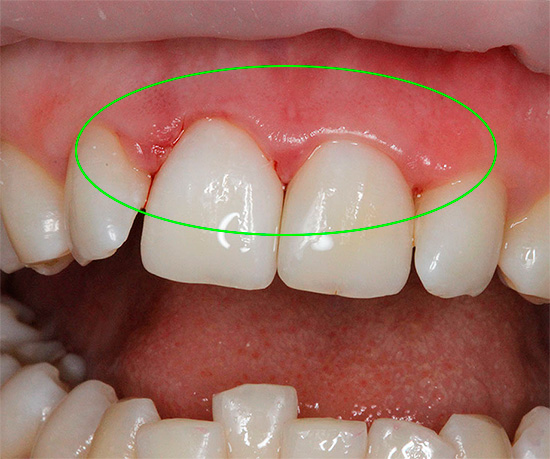
As you can see, with independent execution, the procedure is far from safe. However, cabinet teeth whitening, that is, carried out by a specialist in the clinic, along with very high efficiency can still be described as completely safe, since with the right approach, almost all undesirable effects can be avoided, or eliminated in a short time.
How safe is the use of whitening toothpastes
How safe is fast driving? Of course, as much as the person sitting at the wheel knows how to drive transport at that speed. No less important is the vehicle itself.
Similarly, the choice of even a good high-quality whitening paste does not reduce the role of a person in the competent cleansing of the surface of enamel from plaque. The use of highly abrasive whitening toothpastes should be made with a full understanding of how this procedure affects your teeth and what can happen if the toothpaste is not used correctly.
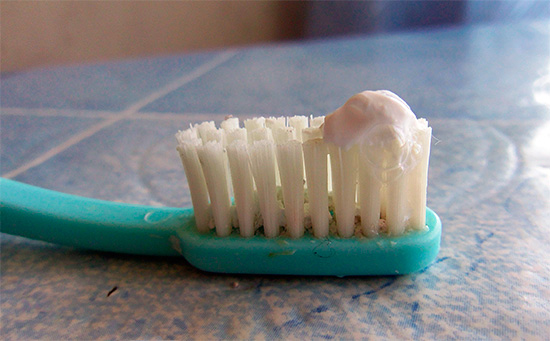
It is certainly difficult to call the use of such pastes the safest teeth whitening, and the wording “whitening” is clearly not suitable here, since it is more correct to talk about lightening. If used correctly, such a paste could be called “well-cleaning plaque”, and if the brushing technique is impaired (excessive pressure on the brush, the prevalence of circular movements, etc.) - “abrasive enamel and leading to increased sensitivity”.
Especially harmful is the use of abrasive whitening toothpastes in people with hypersensitive teeth — moreover, such people often don’t think about it, and they want to whiten their smile no less than others, and so they carefully abrade their thinned enamel.
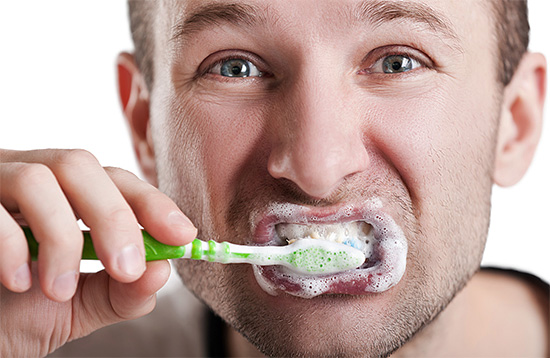
It is interesting
I would especially like to note the groups of whitening toothpastes in which the abrasive system is combined with the presence of carbamide or hydrogen peroxide in the composition of the peroxide (on the package of such a product it can be written “With active oxygen”). So, the concentration of peroxides in such pastes is so low (many times lower than even in strips and pencils for home teeth whitening), and the pH of the medium is so high that no effective chemical bleaching can be discussed.
However, the advertising effect is obvious - many believe that since “active oxygen” is present in the composition of the toothpaste, then the yellow color of the teeth should certainly become discolored, and the smile will quickly glow with whiteness ...
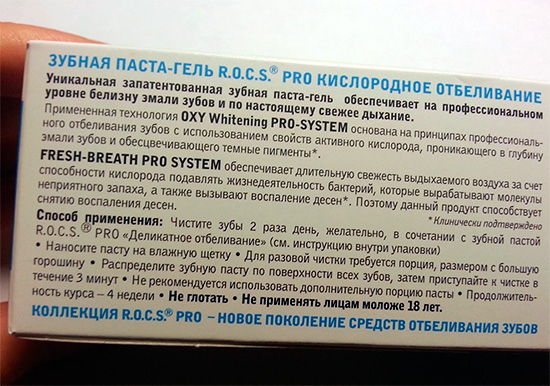
However, there are also whitening toothpastes, characterized by an average abrasion index (RDA of 75) and therefore suitable for daily use, that is, it can be said to be completely safe for a healthy person’s teeth. A manufacturer can achieve a bleaching effect as follows:
- The use of special enzymes (bromelain, papain), which are able to destroy the protein matrix of plaque;
- Using sodium or potassium pyrophosphates are effective complexing agents that extract and bind calcium ions from the structure of tartar and, as a result, make it more malleable to mechanical cleansing;
- And also due to a specially selected abrasive system (different particle shape, particle material, etc.) - for example, toothpaste President Renome.
Such pastes provide gentle whitening (lightening) of enamel. Examples: Toothpaste Splat Whitening Plus, Sensodyne Gentle whitening, ROCS Coffee and tobacco, etc.
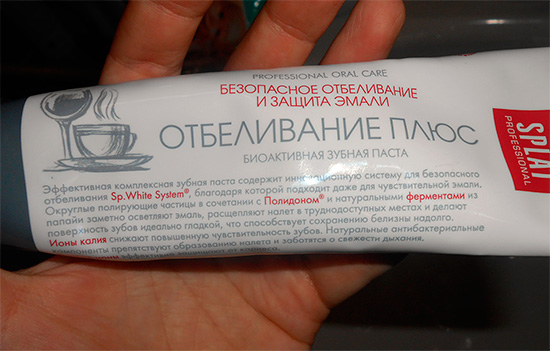
About the principle of operation and safety of Air Flow technology
Air Flow is a technology of mechanical “whitening” of teeth, aimed at removing plaque from their surface using a special apparatus (similar to sandblasting).
Perhaps you should immediately debunk some myths about this procedure:
- During the procedure, true enamel bleaching does not occur, however, as a result of getting rid of plaque in more than 80% of cases, the teeth really become noticeably whiter;
- In many literary sources, the Air Flow device is called a sandblasting device, although in fact it is advisable to call it sodblasting - the principle of Air Flow is based on cleaning teeth from plaque using a powerful jet of an aqueous suspension of sodium bicarbonate (ordinary baking soda).
To date, the Air Flow technique is one of the best and safest ways to “whiten” teeth, since during the procedure no harm is caused to the internal structures of enamel, and the total abrasive effect is strictly controlled by a specialist.
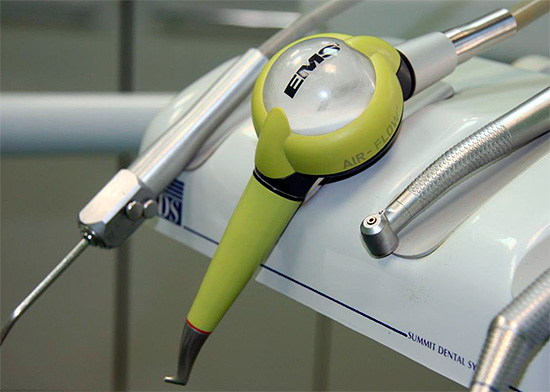
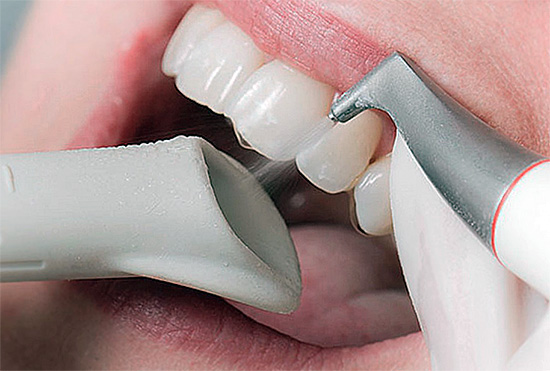
Nevertheless, a jet of soda, released under high pressure, may, during the process of polishing the enamel, slightly disturb its surface layer. That is why immediately after such professional brushing, the dentist must remineralize and (or) fluoride the enamel without fail.
It is interesting
The most common method of tooth fluoridation after Air Flow is applying a special fluorinating gel on an individual mouthguard to the surface of the cleaned enamel. Usually the entire fluorination procedure lasts no more than 1-2 minutes.
Pros of teeth whitening using Air Flow technology:
- Effective and quick cleansing of all surfaces of the teeth (even hard to reach toothbrushes) from colored plaque occurs after coffee, tea, cigarettes, etc .;
- Air Flow is a gentle procedure, it is almost always painless, and is suitable even for sensitive teeth;
- After cleansing from plaque, the teeth become lighter by 1-2 tones without a significant violation of the enamel structure.
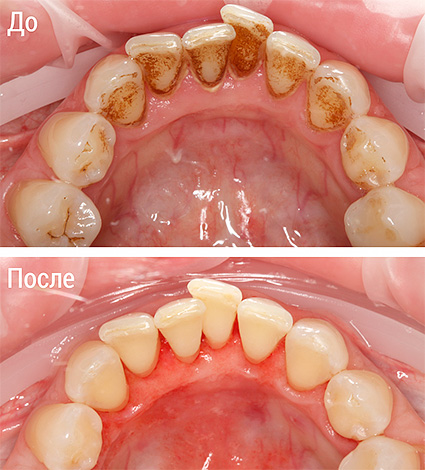
Contraindications to this procedure concern mainly people with bronchial asthma and serious pulmonary disorders, as well as patients on a salt-free diet.
Feedback:
“... They sat me down in a chair, put on a hat and glasses. At first they carried out ultrasonic brushing, although I had very little tartar. Then it was the turn of Air Flow, it is such a powerful jet that you can easily cut the gums. Here the glasses helped, as they saved from small splashes. It doesn’t feel much better than ultrasound, but between the teeth it’s sure to clean everything. Then came the turn of fluoridation, smeared with some kind of paste or gel, rubbed fluoride into the enamel. But then what a bliss to feel freshness in the mouth, the teeth became whiter, their natural color returned to them. Of the problems, I can only note that the gums were bleeding for a while, and everything was quite bearable. ”
Olga, Samara
Ultrasonic methods for mechanical teeth whitening
Ultrasonic teeth whitening is also a gentle and completely safe way to brighten tooth enamel. As in the case of Air Flow technology, ultrasonic tooth clarification techniques are aimed at cleaning surfaces from pigmented deposits.
Perhaps the main difference between the use of ultrasound is the possibility of a very effective removal of tartar (supra- and subgingival), while using soda blasting it is almost impossible to achieve.
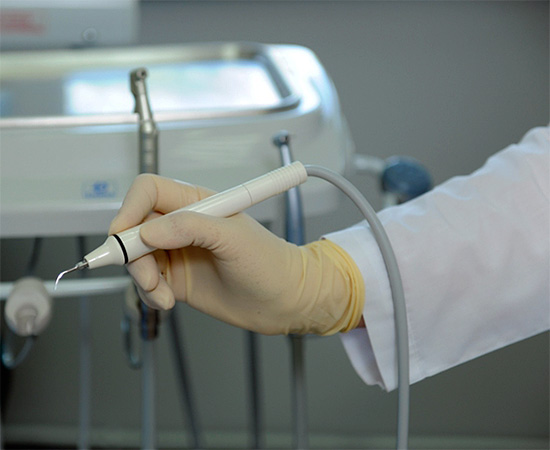
On a note
That is why dentists often implement professional oral hygiene using two methods: first, tartar is cleaned with an ultrasonic device or a special nozzle (scaler), and then Air flow technology is used. Thus, the teeth are first freed from tartar, and only then from plaque from all surfaces.
In principle, plaque can be removed with ultrasound, but it will take more time and it is not always possible to get to hard-to-reach intervals.
Professional hygiene always ends with preventive fluoridation of all teeth.
After ultrasound removal of tartar (and in some cases plaque), the teeth become lighter by 1-2 or more tones. The principle here is simple: the more “dirt” was on the teeth, the more pronounced the effect.
So ultrasonic teeth whitening can also be attributed to one of the best and safest, as there is no effect on the deep structures of enamel. Therefore, ultrasound is suitable even for sensitive teeth - adjusted for the fact that in rare cases it is necessary to carry out infiltration anesthesia in order to make the patient as comfortable as possible.
Whitening strips, mouth guards, pencils and chewing gums
Let's start with the whitening chewing gum. Everything is simple here - this is the most common myth that bleaching chewing gums can really lighten enamel. Many people around the world continue to use them in the hope of a miracle, although in practice no miracle happens, unless the pockets of manufacturers of such chewing gum are miraculously filled.
Do not believe it, but there are also chewing gum for weight loss, for heartburn, for arousal. Perhaps soon there will also be chewing gum from baldness and hemorrhoids - why not ...
Further. The so-called whitening strips are one of the most convenient means of home teeth whitening, and are really able to give a noticeable result. The principle of whitening is that special gel strips are applied to the surface of the front groups of teeth, and enamel bleaching occurs due to the presence of hydrogen peroxide in the gel (however, this method is neither gentle nor safe - this will be discussed later).
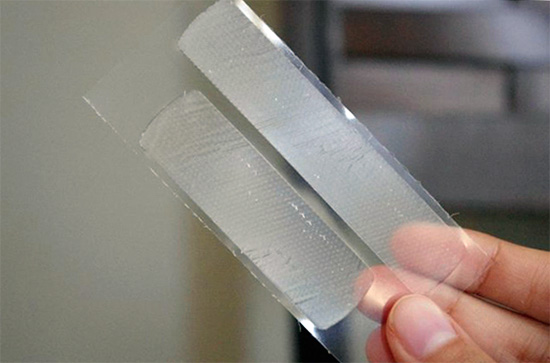
Depending on the concentration of active ingredients in the strips (which is determined by the manufacturer, quality of the product, shelf life), the effect can be achieved at different intervals: the enamel becomes noticeably lighter usually within 1-2 weeks, although sometimes a positive result is not achieved at all.
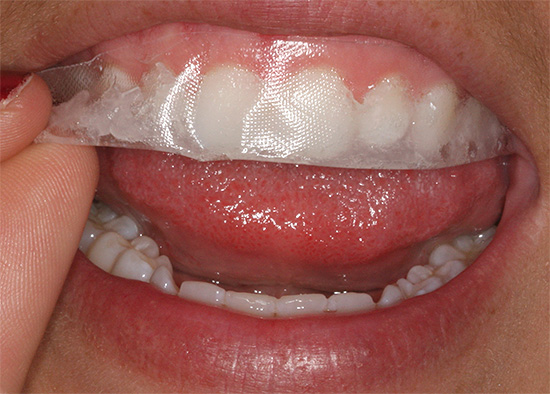
Consider why in some cases the result can be almost zero:
- Bleaching strips are not able to remove plaque and tartar from the surface of the enamel. Even cabinet whitening is not carried out on "dirty" teeth, as it would be ineffective;
- The concentration of peroxides in most tooth whitening strips on the market is significantly lower than in professional whitening products - this is due to the fact that the manufacturer initially thinks about the safety of the procedure performed by an untrained person at home.
On a note
In general, strip whitening can hardly be called a gentle and safe method, since this does not take into account the individual characteristics of each individual person. For example, with sensitive tooth enamel, such whitening will become a real torture, as well as for people who have serious problems with the gums (especially with incorrect use of strips).
When active components get on the gum and stay in contact with it for a long time, an inflammatory process develops. In fact, this is a chemical burn, which can pass by itself after a short period of time, but sometimes leads to primary inflammation of the gums or causes an exacerbation of existing chronic foci.
Now a few words about bleaching mouthguards.
At the moment, mouthguards that are used for independent home use (most often from China) have many negative reviews. The reasons are the same: low concentrations of peroxides and (sometimes) the presence of plaque and stone, which greatly interfere with the desired effect.
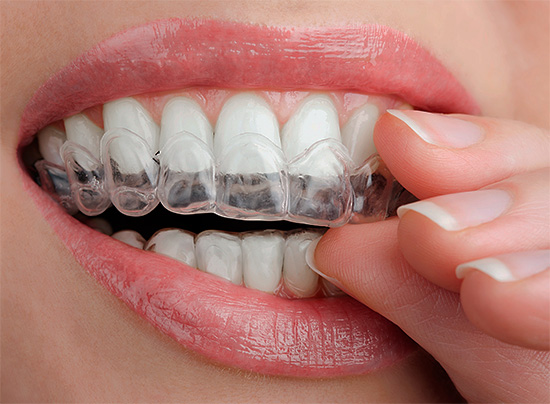
When using whitening mouthguards, the best and relatively safe option for home teeth whitening is to use individual mouthwashes made by the dentist in a mold.As a rule, they are used after preliminary cleansing of the enamel from stone and plaque, and also (almost always) - after the carried out cabinet whitening of teeth - to consolidate the result.
Such mouthguards with whitening gel for home use have detailed instructions and individual recommendations, due to which during and after the whitening procedure the risks of damage to the enamel and oral mucosa are minimized.
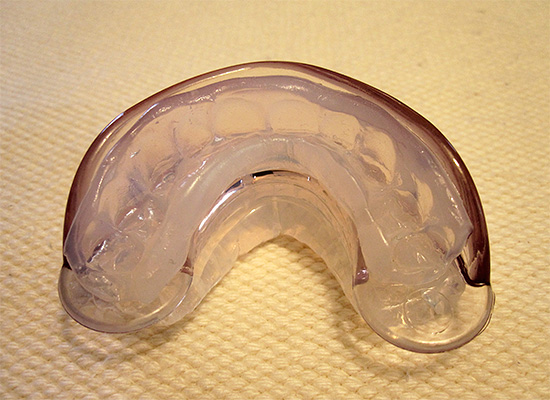
It's important to know
It is almost impossible to completely exclude the possibility of developing inflammation on the marginal gum, however, each patient always has a feedback from the attending physician. Usually, whitening gels and mouthguards are prescribed by the dentist as a fixing procedure after the main whitening, but often the pleasant addition is the effect of even more enamel clarification (by 1-2 tones).
Of course, with such high efficiency it is difficult to call this type of whitening gentle, but the most important plus is its controllability, which greatly increases the safety of the procedure.
Also worth mentioning are whitening pencils, which, generally speaking, are a very controversial tool for home teeth whitening (effective, but safety largely depends, as they say, on the “curvature of the hands” of a person).
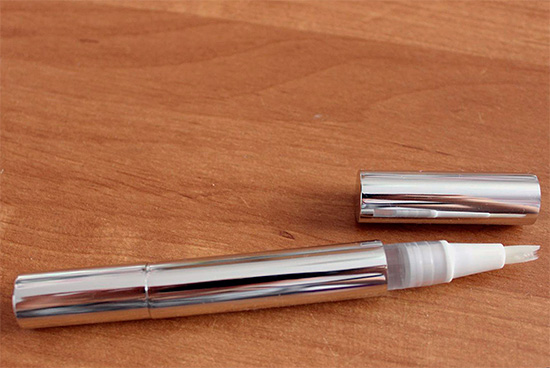
Feedback:
“I bought myself a teeth whitening pencil in Los Angeles. In just 2 weeks, my teeth became much brighter than they were, it’s only a shame that already on the 3rd day they started to hurt so much when bleaching that there is almost no urine. And then it hurts, but I suffer, because beauty requires sacrifice! ”
Yana, Moscow
The principle of operation of whitening pencils is quite simple: the gel contained in the pencil is squeezed onto the surface of the front teeth (see the example in the photo below), then it is required to continue to smile for some time to dry the composition.
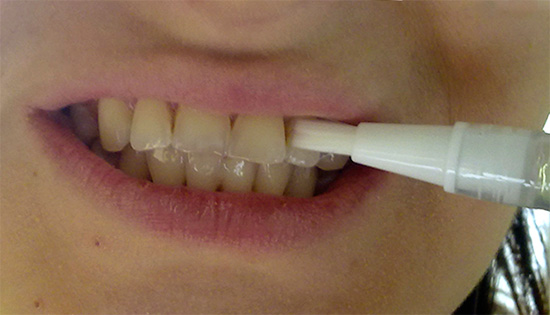
For the safety of whitening procedures for gums and mucous lips, pencils from reliable manufacturers have a not very high concentration of enamel brightening components.
On a note
A review of popular sites with reviews shows that most opinions related to the use of pencils for teeth whitening are negative, and this is quite logical from the point of view of medicine and human logic. The fact is that in the market for these whitening products there are often low-quality fakes from China, which are massively bought and sold through popular online stores. Moreover, roughly speaking, they are purchased for 100 rubles, and sold for 500-1000.
Secondly, whitening pencils purchased abroad, one can say from a company, are in demand and have a sufficient number of pluses, but the mentality of our population is not taken into account. It should be recalled that effective whitening pencils, which brighten teeth for 1-2 or more tones within 1-2 weeks, do not work on teeth with abundant plaque and stone and damage the enamel structure (especially sensitive) to one degree or another.
Teeth Whitening
Cabinet or, in other words, professional teeth whitening is carried out by the dentist using gels containing hydrogen peroxide (or its derivatives). The procedure can be carried out with or without a catalyst, and heat, a laser, and ultraviolet can be used as catalysts.
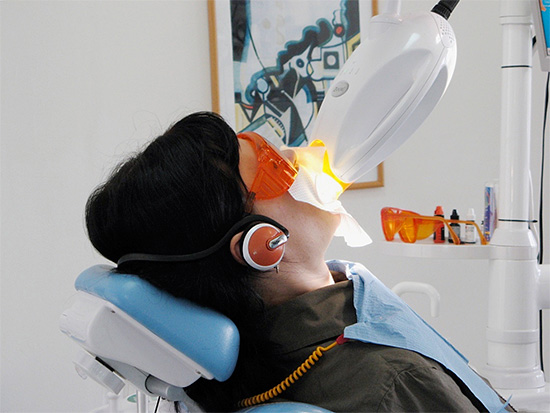
It is interesting
Some clinics position carbamide peroxide in a whitening gel as a more effective means compared to hydrogen peroxide. However, in an aqueous medium (in the process of contact of this compound with tooth tissues), carbamide peroxide decomposes into hydrogen peroxide and urea, so there is no significant difference.
The principle of any type of cabinet whitening is that the active components of the whitening gel are able to penetrate to some depth in the tooth enamel (between microcrystals of hydroxyapatite, fluorapatite), discoloring the colored compounds accumulated here over the years. The surface of the tooth becomes lighter.
The final bleaching result depends on many factors, but the main ones are as follows:
- The quality of the material used (here it is not so much about the safety of the gel for enamel, but about the percentage of the active component, the rheology of the gel, the presence of a stabilizer and other excipients);
- The presence of additional activators that accelerate the procedure and to one degree or another determine the final color of the tooth;
- Gel exposure time.
It is possible to carry out cabinet whitening of sensitive teeth, but this procedure cannot be called gentle and safe. If the client insists on his knowledge of the increased sensitivity of the enamel, then during the procedure very severe pain may occur. As a result, although the effect can be achieved, enamel will be dealt significant damage (you will need enhanced remineralization and fluoridation).
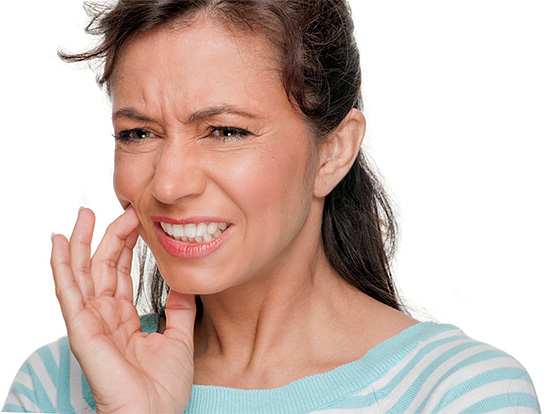
In any case, cabinet whitening is considered the best (effective) way to achieve whiteness., but the cost of the procedure may not be affordable for everyone. It is also useful to know that such a conscious spoilage of tooth enamel is actively criticized by doctors who approach the problem from the point of view of the benefit for the person, rather than the commercial benefit. In practice, the situation is such that up to 30-50% of people who whiten either do not need to see a dentist every day (since the existing shade of tooth enamel is given by nature and its lightening is a waste of time), or is contraindicated (for some gum diseases , as well as pregnant and lactating mothers, with allergies to bleaching components, etc.).
The most important difference between cabinet whitening from independent (home) is its controllability. A professional dentist will make every effort to minimize the risks and undesirable consequences of the procedure. For example, special attention is paid to protecting the mucous membrane from getting gel on it, which is difficult to achieve with home-made bleaching types - therefore, it is not uncommon to contact dentists with burns of the mucous membrane, for example, after applying bleaching strips or pencils.
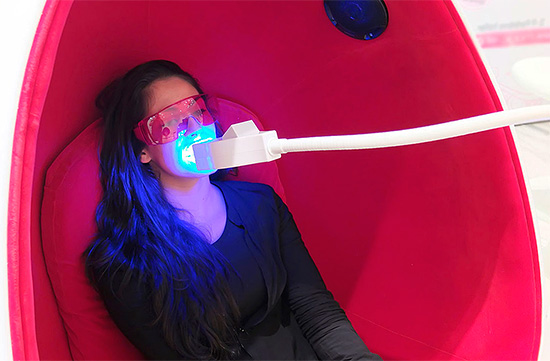
Important
Most people suggest that the tooth should be whitened uniformly, but in practice this usually does not happen. Normally, the tooth has several areas of shades: usually from the darkish cervical region, to the white middle and almost transparent incisal edge.
If a competent cabinet bleaching is carried out, then the color transitions will remain the same, but their shade will become lighter. It is worth remembering that fangs are almost always slightly yellower than other teeth. And if there are fillings, especially in the smile zone, then after bleaching the color difference between the enamel and the seal can become very noticeable.
Also, do not refer to the Hollywood smile of celebrities, since the blinding uniform whiteness of teeth is almost always achieved simply and very expensive: with the help of modern types of crowns, veneers and lumineers. Moreover, it should be noted that, for example, veneers and lumineers can be securely attached to the teeth without their preliminary processing (“turning”). This is a great and safe alternative to knowingly damaging tooth enamel with almost any kind of whitening.
How safe are folk whitening products?
Among a large number of folk methods for brightening teeth, the most popular are perhaps all kinds of variations using soda, salt, lemon, wood ash (or coal) and strawberries.Most of these experiments on teeth cannot be called safe tooth whitening, as evidenced by the reviews of those who experienced this on themselves.
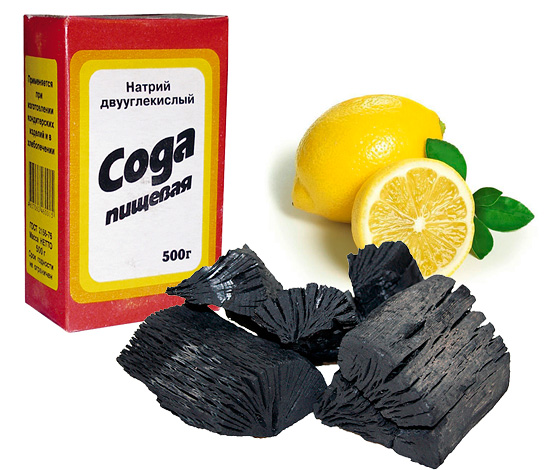
Feedback:
“I recently read in a magazine that teeth can be whitened with a mixture of charcoal, soda and salt. He took birch charcoal for barbecue, chopped it. I mixed it with soda and salt in approximately equal parts and tested on myself. I’ll tell you just tin. I don’t know what about the teeth, I didn’t notice that they became lighter, but my gums were corroded in just 3 days thoroughly. Inflamed, began to bleed. On the fourth day I could no longer brush, I returned to my usual toothpaste ... "
Oleg, St. Petersburg
Firstly, each person differently understands the algorithms associated with grinding and polishing teeth with the same soda mixed with something. Secondly, everyone has a different understanding of the measure (someone can gently brush their teeth for 1 minute, and someone can frantically rub a quarter of an hour). Thirdly, each person has a different state of the gums, as well as the amount of plaque on the surface of the enamel and its individual color characteristics.
Almost all folk teeth whitening methods They are aimed exclusively at cleaning plaque, which is achieved by abrasives (soda, charcoal), organic acids from fruits, vegetables, etc. Isn’t it easier instead of scratching the enamel with soda or salt, just buy quality whitening toothpaste, even if it is more abrasive, and take a whitening course yourself more safely (for example, ROCS toothpastes whitening, Mexidol Dent Professional White, President White Plus, etc. may be suitable)
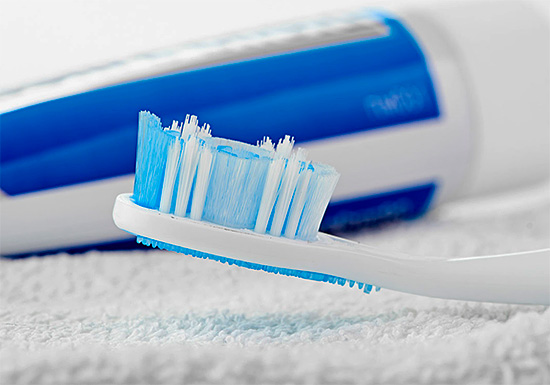
You can also go to the dentist and remove plaque and stone from all surfaces of the teeth, and after the procedure every day carry out an independent 3D-cleaning of your teeth from soft plaque using toothbrushes, special pastes and dental flosses. With adequate oral hygiene, the dentist will need to repeat the procedure of professional cleaning no more than 1 time per year.
Rules for eating after teeth whitening
Recommendations after teeth whitening are an important stage in the work of the dentist, which allows to some extent protect your work from possible claims by the patient.
Firstly, you will definitely be warned about increased tooth sensitivity for several days. Even after the restoration of the damaged enamel structure (during remineralizing therapy), the teeth most often have a “hard time”, so it takes time to return to the previous fullness of life.
Secondly, after teeth whitening, a so-called white diet will be prescribed or a list of foods that are strictly forbidden to eat and drink during the first week will be given. Of course, it is desirable to exclude cigarettes, strong coffee, tea, red wines for the longest possible time. Such a “transparent” diet after teeth whitening allows you to increase the lifespan of the resulting Hollywood smile.
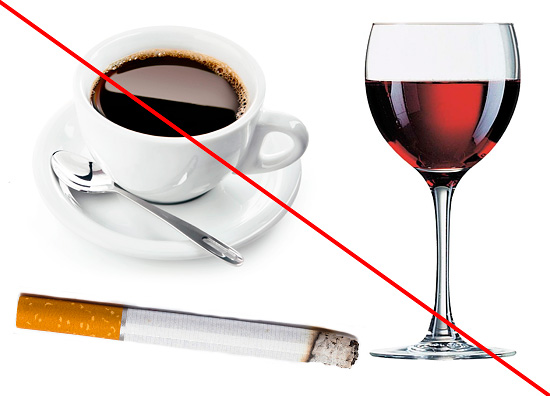
It is interesting
Practice shows that only a few people are able to completely abandon dyes for at least a week: from tea and wine, and ending with chocolate and berries. Also rare are cases of a complete rejection of cigarettes and coffee in order to maintain a snow-white smile, which has come at a high price (in both literal and figurative sense).
That is why Russian dentists can be calm about their teeth whitening work, because even despite achieving a first-class result, after some time the client will again fall into the arms of his beloved “cosmetologist dentist”.
Absolutely Safe Whitening
To summarize a short summary.
The question which teeth whitening is the safest can be answered briefly: one that does not harm the tooth tissues, gums and oral mucosa, as well as human health in general. And if so, then it can be concluded that today there is no absolutely safe tooth whitening.The only question is during which procedure a fairly good result will be achieved with the relatively small damage that the enamel and gums will receive during the procedure.
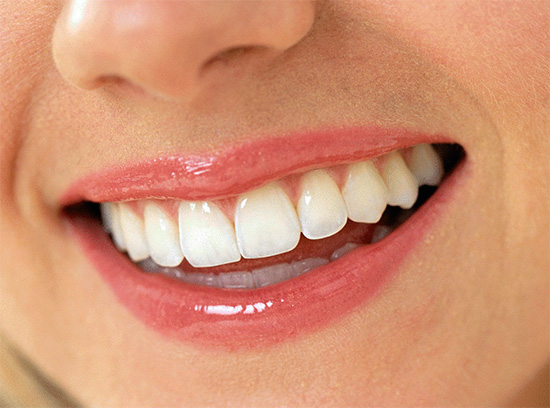
Do not confuse professional oral hygiene (ultrasound and Air Flow) with true tooth enamel whitening procedures. During hygiene, the tooth surface is cleaned of deposits, under which there is a lighter enamel. For someone after the procedure, this becomes a pleasant surprise, and for not quite respectable dentists - a financial gain, although less and less doctors are ready for commercial reasons to replace these simple concepts.
As a result, professional hygiene allows you to make your teeth brighter, and almost always more or less safe for enamel.
Of the true methods of teeth whitening, it is difficult to choose any gentle and safe, since it is almost impossible to maintain objective statistics on the percentage of effective and ineffective whitening procedures, as well as on the number of obvious failures and related side effects in the form of enamel damage, chips, burns of the oral mucosa, allergies, long-lasting enamel hypersensitivity, etc.
Therefore, the following sequence of actions is recommended before teeth whitening:
- consult a dentist;
- carry out professional oral hygiene (if there is evidence), getting rid of tartar and plaque - already at this stage the smile can become noticeably whiter;
- and only then, having weighed the pros and cons, it’s good to think and decide for yourself: is it worth risking the health of your teeth for the sake of a possible even more snow-white smile, and how much willpower and patience can be enough to devote some part of your life to “white” diet. If you are willing to take a chance, then choose a room-based teeth whitening - so much less risk to burn your gums and irreparably destroy the enamel.
Well, if you already have experience with teeth whitening, do not forget to leave your review at the bottom of this page. Perhaps this review will help someone make their choice.
Useful video on the issue of the safety of office teeth whitening, as well as contraindications to this procedure
The danger of home teeth whitening: expert comments and reviews of ordinary people

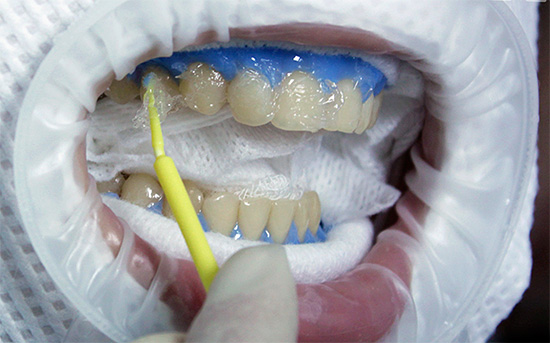
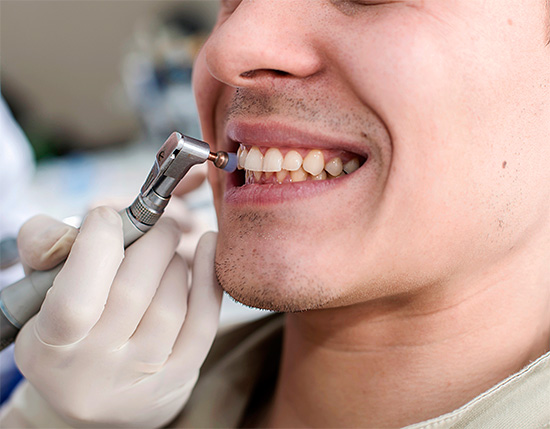
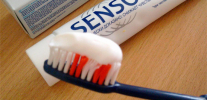
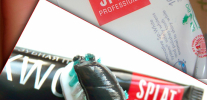
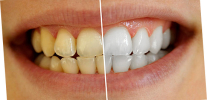
Never do mechanical brushing, even in the office, even at home - the process is irreversible, and then no fluoride and calcium will simply help you. Protect your teeth from a young age and rinse your food with a rinse after each meal. And then you will not need to go to the dentist and carry a lot of money for treatment.
I think in many cases it’s enough to choose a paste with a calcium-abrasive property and at the same time wound healing, a little with a tanning effect for the gums, as well as a soft toothbrush. And work once a day over all your teeth, especially where you need to whiten!
Thank you for the article! 🙂
For a long time I wanted to whiten my teeth, and now I thought, do I need it? I try to take care of the teeth, visit the dentist, do the cleaning 1 time in 1.5 years. Even dentists say that I have a good (natural) tooth color. But you want to! ) Good article. Thanks.
These are all tricks, we are shown in advertising with people with an unnatural tooth color and it seems to us that this should be so. But in reality, a healthy tooth color cannot be the same as the color of a white toilet bowl))